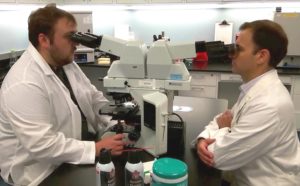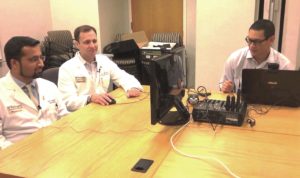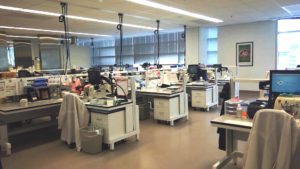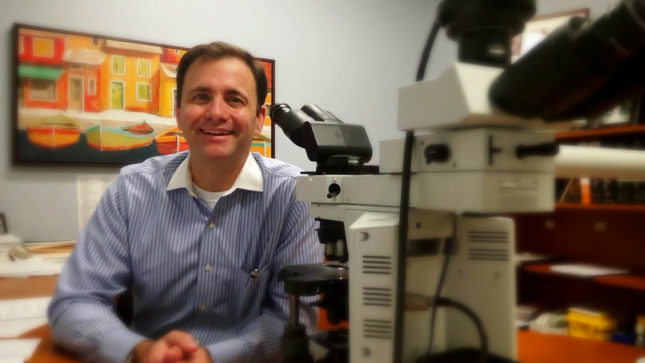Joseph Gaut, MD, PhD, Assistant Professor, Pathology & Immunology, is a busy man.
Being the only pathologist with specialized expertise in renal pathology here at WashU, Dr. Gaut signs out every kidney biopsy that comes through the division. This includes all medical biopsies, all transplant biopsies from Barnes-Jewish and Children’s Hospitals and biopsies sent in from other areas. In all, that is over 350 kidney biopsies a year.
 Dr. Gaut personally examines each biopsy – the work-up of which involves analysis by light, immunofluorescent and electron microscopy – and within 24 hours calls the submitting nephrologist with the results. “It is a very small core [sample] and these biopsies aren’t trivial to do and sometimes we are dealing with very limited tissue, but we squeeze in an awful lot of information from a tiny, tiny piece of tissue,” he says.
Dr. Gaut personally examines each biopsy – the work-up of which involves analysis by light, immunofluorescent and electron microscopy – and within 24 hours calls the submitting nephrologist with the results. “It is a very small core [sample] and these biopsies aren’t trivial to do and sometimes we are dealing with very limited tissue, but we squeeze in an awful lot of information from a tiny, tiny piece of tissue,” he says.
Analysis of the biopsy provides a major opportunity for teaching. Gaut says that when a biopsy is reviewed, it is frequent for the entire clinical team, including the attending nephrologist, the fellow who is on service at that time, visiting/rotating medical students as well as rotating residents in internal medicine, to congregate and examine the biopsy images.
“We certainly have a large group of folks who come by and we all look at the biopsies together on a large multi-headed scope and review all the major findings right here at the microscope.”
The Division of Nephrology’s weekly conferences for fellows often require Dr. Gaut’s expertise. When a major portion of the conference involves pathology, he will review the case with the presenting fellow prior to the conference. During the pathology section of the conference, Gaut will then guide a fellow who is not familiar with the case through the biopsy findings.
“So, it’s kind of a question and answer type of a format where I actually describe what’s there and then I’ll point out additional details that they may or may not have missed,” Gaut says. “We will go through each pertinent finding for that particular case until they arrive at their diagnosis.”

Left to right: Drs Younus, Gaut and Yau prep for YouTube video series.
Gaut also participates in the WashU Nephrology YouTube Video Series, an exciting educational initiative aimed at teaching clinical nephrology to trainees in a web-friendly manner. He and series creator and moderator Timothy Yau, MD, guide renal fellows in reading a biopsy and rendering a diagnosis. The web series recently won the NephJC’s Nathan Hellman Social Media Innovation of the Year award, and is fast approaching 20,000 views.
Aside from his clinical and teaching contributions, Gaut also provides pathology support for research projects within the division. “I’ve done quite a bit of work with Dr. Sanjay Jain. He and I have collaborated on numerous projects ranging from acute injury to genetics of kidney disease, and others, in addition to working on the textbook Diagnostic Pathology: Kidney Diseases, 2nd Edition.” The book, of which Gaut and Jain are co-authors, was just awarded First Prize in the British Medical Associations annual Medical Book Awards (see more on the book here.)
Gaut is currently involved in the development of a novel biomarker for acute kidney injury (AKI). His recent publication in Clinical Chemistry details the development of an immunoassay for myo-inositol oxygenase (MIOX), a renal-specific, proximal tubule protein that is increased in the plasma of critically ill patients with AKI. Levels of MIOX precede increases in creatinine concentration by about two days in human patients (see publication here). Gaut is collaborating with Anitha Vijayan, MD, on a project involving MIOX. “We are just finishing up a large clinical trial prospective study evaluating patients undergoing cardio-pulmonary bypass surgery. It was a long, difficult project. It was 100 hundred patients getting cardiac surgery, 7 samples per patient, so 700 samples that we have to analyze. It’s a big project.”

New pathology lab.
Gaut grew up in Springfield, MO, and received his undergraduate degree (magna cum laude) in Chemistry at WashU. He continued at WashU in the eight-year MD/PhD program, researching oxidative tissue injury for his thesis. Following an internship in general surgery at Barnes Hospital, he did a two-year postdoctoral fellowship investigating novel biomarkers for brain and kidney injury. He completed his anatomic pathology training at Massachusetts General Hospital in Boston, MA, and his clinical pathology training (fellowships in renal pathology and surgical pathology) at WashU.
During his clinical pathology training, he worked very closely with Helen Liapas, MD, who was Section Head of Renal Pathology at the time. “I really wanted to be a renal pathologist,” Gaut says. “I had [about] a year’s worth of elective time during those two years, and I spent all of it doing renal pathology with her. Over those two years, I reviewed every single biopsy that came through and we talked about every single case. That was my training period, sort of an unaccredited fellowship, so to speak, with Helen.”
Gaut stays busy on his “off” time, too. “Three kids can keep you very busy in the evenings,” he says. One is in college, and the two younger ones who are in high school are both very involved in sports. “I’m always at a tennis game, volleyball game, or something. I sort of spend a lot of time shuttling them around. I have my one morning on Saturday morning when I will go play tennis with an ‘older man’s league’, which is a lot of fun.”
He also likes to cook. “My wife doesn’t do much of the cooking … well, she does some. I like to do that around the house.” When pointed out to him how great that is, he replies, “Yes, she thinks so!”
 And it doesn’t sound like Gaut’s life will be getting less busy any time soon. He expects the number of kidney biopsies to increase. “I’d say in the short term, within the next six months to a year, [it] will increase up to about 150 to 200 cases.” That means a total number of cases of about 500-550 a year. “And within 5 years, if things go successfully, around 1000 cases a year. [Eventually], we’ll need more people!”
And it doesn’t sound like Gaut’s life will be getting less busy any time soon. He expects the number of kidney biopsies to increase. “I’d say in the short term, within the next six months to a year, [it] will increase up to about 150 to 200 cases.” That means a total number of cases of about 500-550 a year. “And within 5 years, if things go successfully, around 1000 cases a year. [Eventually], we’ll need more people!”